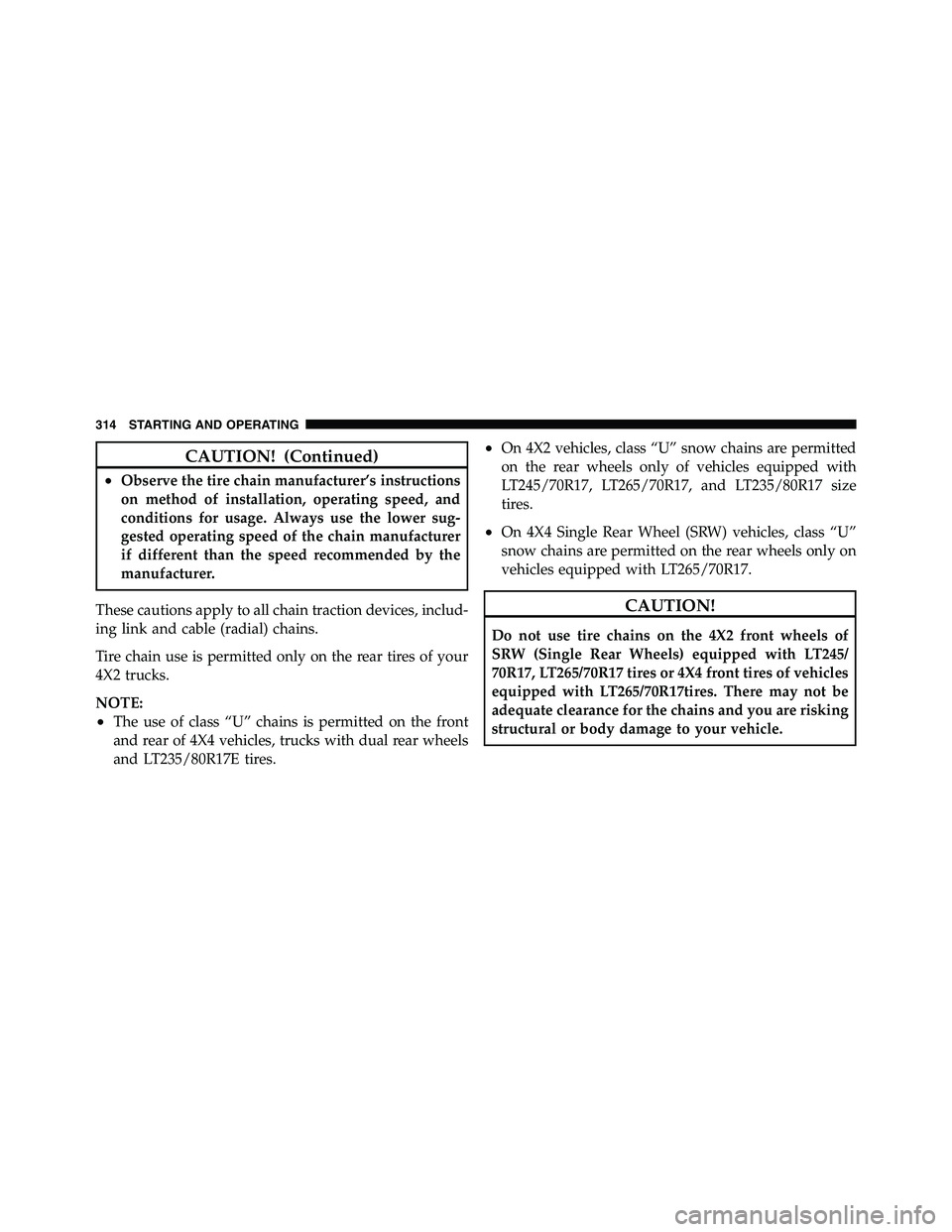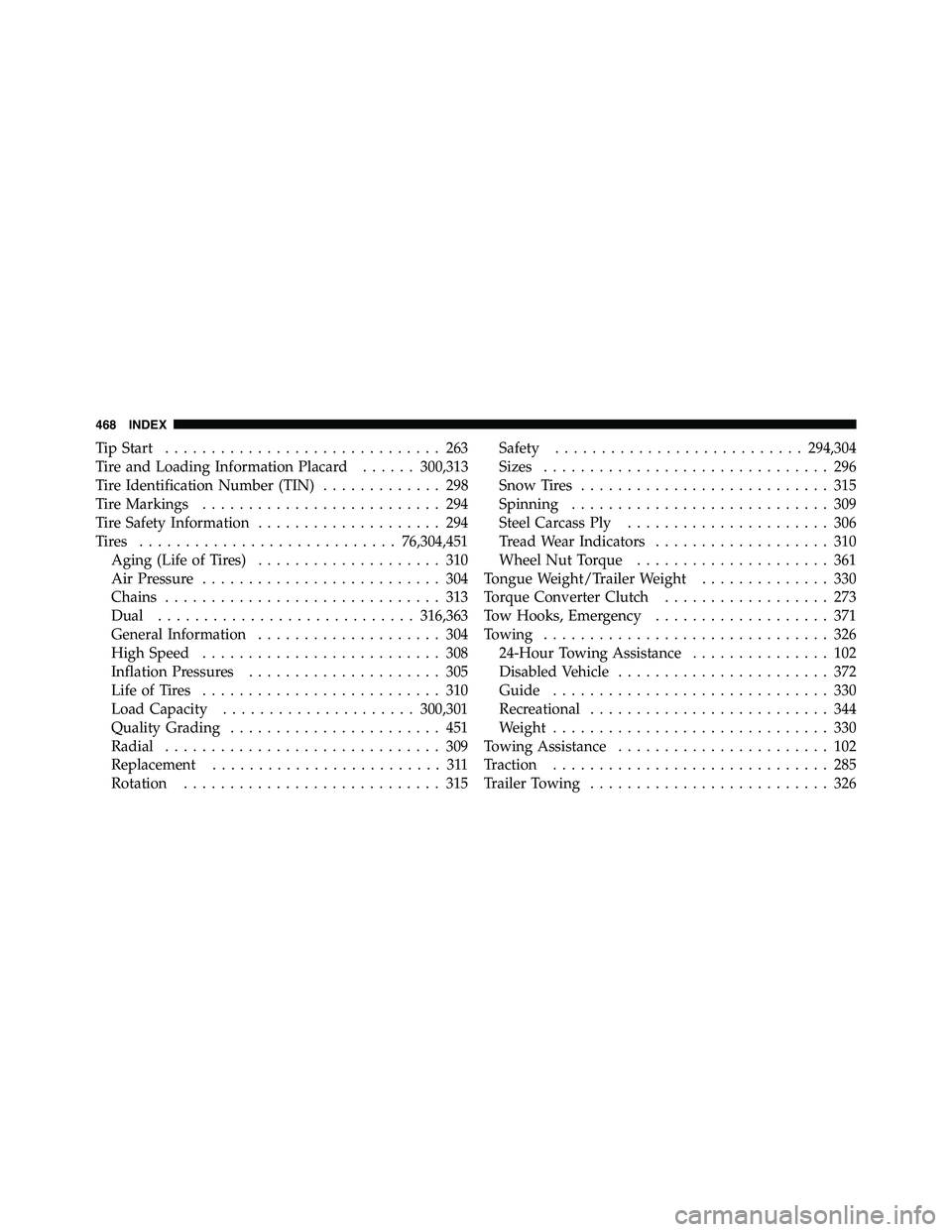tire size RAM CHASSIS CAB 2011 User Guide
[x] Cancel search | Manufacturer: RAM, Model Year: 2011, Model line: CHASSIS CAB, Model: RAM CHASSIS CAB 2011Pages: 472, PDF Size: 7.38 MB
Page 314 of 472
![RAM CHASSIS CAB 2011 User Guide SUPPLEMENTAL TIRE PRESSURE
INFORMATION — IF EQUIPPED
A light load vehicle condition is defined as two passen-
gers [150 lbs (68 kg) each] plus 200 lbs (91 kg) of cargo.
Cold tire inflation pressures RAM CHASSIS CAB 2011 User Guide SUPPLEMENTAL TIRE PRESSURE
INFORMATION — IF EQUIPPED
A light load vehicle condition is defined as two passen-
gers [150 lbs (68 kg) each] plus 200 lbs (91 kg) of cargo.
Cold tire inflation pressures](/img/34/59200/w960_59200-313.png)
SUPPLEMENTAL TIRE PRESSURE
INFORMATION — IF EQUIPPED
A light load vehicle condition is defined as two passen-
gers [150 lbs (68 kg) each] plus 200 lbs (91 kg) of cargo.
Cold tire inflation pressures for a lightly loaded vehicle
will be found on the face of the driver’s door.
TIRE CHAINS
Use “Class U” chains or other traction aids that meet SAE
Type “U” specifications.
NOTE: Chains must be the proper size for the vehicle,
as recommended by the chain manufacturer.
CAUTION!To avoid damage to your vehicle, tires or chains,
observe the following precautions:
(Continued) CAUTION! (Continued)• Because of limited chain clearance between tires
and other suspension components, it is important
that only chains in good condition are used. Bro-
ken chains can cause serious vehicle damage. Stop
the vehicle immediately if noise occurs that could
suggest chain breakage. Remove the damaged
parts of the chain before further use.
• Install chains as tightly as possible and then
retighten after driving about 1/2 mi (0.8 km).
• Do not exceed 45 mph (72 km/h).
• Drive cautiously and avoid severe turns and large
bumps, especially with a loaded vehicle.
• Do not install tire chains on front wheels of 4x2
vehicles.
• Do not drive for a prolonged period on dry pave-
ment.
(Continued)5 STARTING AND OPERATING 313
Page 315 of 472

CAUTION! (Continued)• Observe the tire chain manufacturer’s instructions
on method of installation, operating speed, and
conditions for usage. Always use the lower sug-
gested operating speed of the chain manufacturer
if different than the speed recommended by the
manufacturer.
These cautions apply to all chain traction devices, includ-
ing link and cable (radial) chains.
Tire chain use is permitted only on the rear tires of your
4X2 trucks.
NOTE:
• The use of class “U” chains is permitted on the front
and rear of 4X4 vehicles, trucks with dual rear wheels
and LT235/80R17E tires. • On 4X2 vehicles, class “U” snow chains are permitted
on the rear wheels only of vehicles equipped with
LT245/70R17, LT265/70R17, and LT235/80R17 size
tires.
• On 4X4 Single Rear Wheel (SRW) vehicles, class “U”
snow chains are permitted on the rear wheels only on
vehicles equipped with LT265/70R17.
CAUTION!Do not use tire chains on the 4X2 front wheels of
SRW (Single Rear Wheels) equipped with LT245/
70R17, LT265/70R17 tires or 4X4 front tires of vehicles
equipped with LT265/70R17tires. There may not be
adequate clearance for the chains and you are risking
structural or body damage to your vehicle.314 STARTING AND OPERATING
Page 316 of 472

SNOW TIRES
Snow tires should be of the same size and type construc-
tion as the front tires. Consult the manufacturer of the
snow tire to determine any maximum vehicle speed
requirement associated with the tire. These tires should
always be operated at the vehicle maximum capacity
inflation pressures under any load condition.
While studded tires improve performance on ice, skid
and traction capability on wet or dry surfaces may be
poorer than that of non-studded tires. Some states pro-
hibit studded tires; therefore, local laws should be
checked before using these tire types. TIRE ROTATION RECOMMENDATIONS
Tires on the front and rear axles of vehicles operate at
different loads and perform different steering, driving,
and braking functions. For these reasons, they wear at
unequal rates. These effects can be reduced by timely
rotation of tires. The benefits of rotation are especially
worthwhile with aggressive tread designs such as those
on On/Off Road type tires. Rotation will increase tread
life, help to maintain mud, snow, and wet traction levels,
and contribute to a smooth, quiet ride.
5 STARTING AND OPERATING 315
Page 326 of 472

Tire Size
The tire size on the Label represents the actual tire size on
your vehicle. Replacement tires must be equal to the load
capacity of this tire size.
Rim Size
This is the rim size that is appropriate for the tire size
listed.
Inflation Pressure
This is the cold tire inflation pressure for your vehicle for
all loading conditions up to full GAWR.
Curb Weight
The curb weight of a vehicle is defined as the total weight
of the vehicle with all fluids, including vehicle fuel, at full
capacity conditions, and with no occupants or cargo
loaded into the vehicle. The front and rear curb weight
values are determined by weighing your vehicle on a
commercial scale before any occupants or cargo are
added. Loading
The actual total weight and the weight of the front and
rear of your vehicle at the ground can best be determined
by weighing it when it is loaded and ready for operation.
The entire vehicle should first be weighed on a commer-
cial scale to insure that the GVWR has not been exceeded.
The weight on the front and rear of the vehicle should
then be determined separately to be sure that the load is
properly distributed over front and rear axle. Weighing
the vehicle may show that the GAWR of either the front
or rear axles has been exceeded but the total load is
within the specified GVWR. If so, weight must be shifted
from front to rear or rear to front as appropriate until the
specified weight limitations are met. Store the heavier
items down low and be sure that the weight is distributed
equally. Stow all loose items securely before driving.
5 STARTING AND OPERATING 325
Page 367 of 472

Disc Wheels Type Nut Stud Size Torque Ft Lbs Torque Newton Meters
Cone 9/16-18 120-150 160-200
Flanged 9/16-18 130-160 190-220
To Stow The Flat Or Spare — If Equipped
Refer to Upfitters Body Builders Guide for information
on stowing your spare tire (if equipped).
HOISTING
A conventional floor jack may be used at the jacking
locations. Refer to the graphics that show jacking loca-
tions. However, a floor jack or frame hoist must never be
used on any other parts or the underbody.
CAUTION!Never use a floor jack directly under the differential
housing of a loaded truck or damage to your vehicle
may result. JUMP-STARTING PROCEDURES
If your vehicle has a discharged battery it can be jump-
started using a set of jumper cables and a battery in
another vehicle or by using a portable battery booster
pack. Jump-starting can be dangerous if done improperly
so please follow the procedures in this section carefully.
NOTE: When using a portable battery booster pack
follow the manufacturer ’s operating instructions and
precautions.366 WHAT TO DO IN EMERGENCIES
Page 469 of 472

Tip Start .............................. 263
Tire and Loading Information Placard ...... 300,313
Tire Identification Number (TIN) ............. 298
Tire Markings .......................... 294
Tire Safety Information .................... 294
Tires ............................ 76,304,451
Aging (Life of Tires) .................... 310
Air Pressure .......................... 304
Chains .............................. 313
Dual ............................ 316,363
General Information .................... 304
High Speed .......................... 308
Inflation Pressures ..................... 305
Life of Tires .......................... 310
Load Capacity ..................... 300,301
Quality Grading ....................... 451
Radial .............................. 309
Replacement ......................... 311
Rotation ............................ 315 Safety ........................... 294,304
Sizes ............................... 296
Snow Tires ........................... 315
Spinning ............................ 309
Steel Carcass Ply ...................... 306
Tread Wear Indicators ................... 310
Wheel Nut Torque ..................... 361
Tongue Weight/Trailer Weight .............. 330
Torque Converter Clutch .................. 273
Tow Hooks, Emergency ................... 371
Towing ............................... 326
24-Hour Towing Assistance ............... 102
Disabled Vehicle ....................... 372
Guide .............................. 330
Recreational .......................... 344
Weight .............................. 330
Towing Assistance ....................... 102
Traction .............................. 285
Trailer Towing .......................... 326468 INDEX